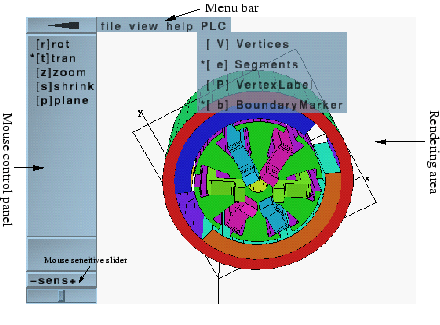Subsections
Three-dimensional Delaunay mesh generation
Collaborator: H. Si,
J. Fuhrmann,
K. Gärtner
Description:
Mesh generation is one of the crucial points for many applications of numerical
methods to real-world problems.
The purpose of this research at WIAS is to provide a reliable and efficient
three-dimensional mesh generation tool based on the up-to-date technologies,
including newly developed algorithms.
TetGen, a 3D Delaunay mesh generator and TetView, a geometry and mesh
visualization and debugging program shall be reviewed here.
TetGen is a 3D tetrahedral mesh generator. It creates tetrahedral meshes
conforming to the Delaunay criteria (so-called conforming Delaunay tetrahedralizations,
or CDT) for arbitrary 3D domains with piecewise linear boundary. It has various
options to refine CDTs and produces high-quality Delaunay meshes which are
suitable for finite element and finite volume methods. TetGen is written in C++.
It is freely available at
http://tetgen.berlios.de
(open source).
A lot of people are interested in using TetGen (about 150 downloads per month).
Clearly, this produces feedback and contacts from all over the world.
Very different applications and the related requirements contribute to
quality improvement.
In the year 2003, the development of TetGen can be divided into two parts: the
release of version 1.2c, and the development of new meshing algorithms.
TetGen Version 1.2c is an improved version of version 1.2,
especially with respect to stability and efficiency. In detail, it has the
following features:
- Improved algorithms for geometric predications using finite
precision arithmetic;
- Detection and handling of two degenerate cases: cospherical
points, coplanar points;
- The input/output user interface ``tetgenio'' was complemented;
- A new boundary edge recovery algorithm for constrained
Delaunay tetrahedralization was included;
- Various quality checking and refinement routines have been added to
improve the quality of the resulting mesh.
TetView is a 3D mesh and geometry viewer. It can be used to view and manipulate
tetrahedral meshes and surface triangular meshes. It views geometries like
piecewise linear complexes, too. The driving force for developing TetView is
the need for efficient visualization working on algorithmic issues of TetGen.
TetView is distributed in executable form for many operating systems.
Figure 3 shows the interactive graphical user interface of
TetView. It uses OpenGL as the kernel for efficiently rendering 3D
objects. Experienced users can exploit the scripting possibilities provided
by Lua to generate animations. The WIAS tools LDF (Lua Data Framework) and
gltools
provided the basis for the TetView development.
Fig. 1:
Mesh of a crystal growth apparatus. (a) shows the input model (a piecewise linear complex) with different boundary markers;
(b) the resulting mesh (cut in the middle to show a view accordingly to (a),
different materials are displayed in different colors;
the model is due to the WIAS crystal growth simulation project, see
page ![[*]](http://www.wias-berlin.de/misc/icons/crossref.gif) ).
).
![\makeatletter
\@ZweiProjektbilderNocap[h]{0.49\textwidth}{sic-plc.eps}{sic-mesh.eps}
\makeatother](img445.gif) |
Fig. 2:
Quality mesh of a geological model of volcano Merapi
(Java/Indonesia, model provided by
C. Rücker, Institute for Geophysics and Geology of the University of Leipzig).
![\makeatletter
\@ZweiProjektbilderNocap[h]{0.49\textwidth}{merapi-mesh-all.eps}{merapi-mesh.eps}
\makeatother](img446.gif) |
Fig. 3:
Example view of the graphic user interface of TetView
 |
LaTeX typesetting by I. Bremer
2004-08-13
![\makeatletter
\@ZweiProjektbilderNocap[h]{0.49\textwidth}{merapi-mesh-all.eps}{merapi-mesh.eps}
\makeatother](img446.gif)